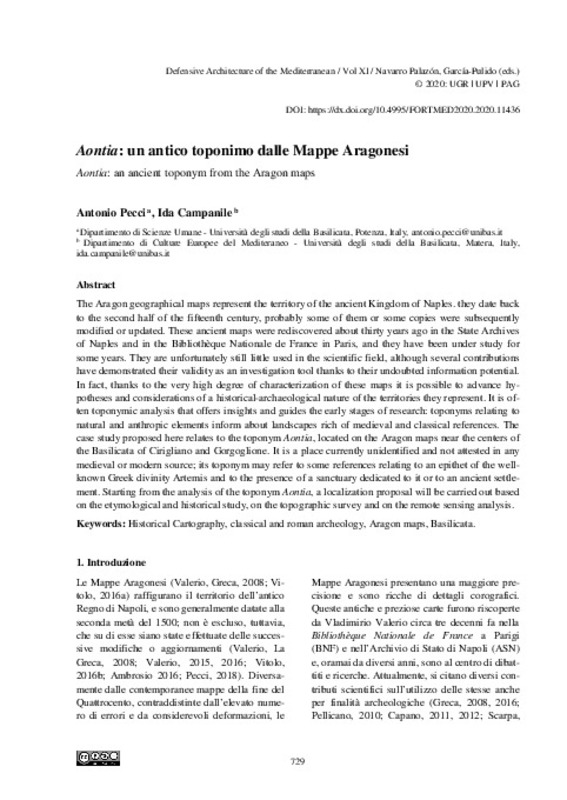JavaScript is disabled for your browser. Some features of this site may not work without it.
Buscar en RiuNet
Listar
Mi cuenta
Estadísticas
Ayuda RiuNet
Admin. UPV
Aontia: un antico toponimo dalle Mappe Aragonesi
Mostrar el registro sencillo del ítem
Ficheros en el ítem
| dc.contributor.author | Pecci, Antonio
|
es_ES |
| dc.contributor.author | Campanile, Ida
|
es_ES |
| dc.coverage.spatial | east=-0.9056622999999998; north=41.5976275; name=Aragón, Zaragoza, Espanya | es_ES |
| dc.date.accessioned | 2020-07-06T11:50:05Z | |
| dc.date.available | 2020-07-06T11:50:05Z | |
| dc.date.issued | 2020-05-15 | |
| dc.identifier.isbn | 9788490488560 | |
| dc.identifier.uri | http://hdl.handle.net/10251/147492 | |
| dc.description.abstract | [EN] The Aragon geographical maps represent the territory of the ancient Kingdom of Naples. they date back to the second half of the fifteenth century, probably some of them or some copies were subsequently modified or updated. These ancient maps were rediscovered about thirty years ago in the State Archives of Naples and in the Bibliothèque Nationale de France in Paris, and they have been under study for some years. They are unfortunately still little used in the scientific field, although several contributions have demonstrated their validity as an investigation tool thanks to their undoubted information potential. In fact, thanks to the very high degree of characterization of these maps it is possible to advance hypotheses and considerations of a historical-archaeological nature of the territories they represent. It is often toponymic analysis that offers insights and guides the early stages of research: toponyms relating to natural and anthropic elements inform about landscapes rich of medieval and classical references. The case study proposed here relates to the toponym Aontia, located on the Aragon maps near the centers of the Basilicata of Cirigliano and Gorgoglione. It is a place currently unidentified and not attested in any medieval or modern source; its toponym may refer to some references relating to an epithet of the wellknown Greek divinity Artemis and to the presence of a sanctuary dedicated to it or to an ancient settlement. Starting from the analysis of the toponym Aontia, a localization proposal will be carried out based on the etymological and historical study, on the topographic survey and on the remote sensing analysis. | es_ES |
| dc.language | Italiano | es_ES |
| dc.publisher | Editorial Universitat Politècnica de València | es_ES |
| dc.rights | Reconocimiento - No comercial - Sin obra derivada (by-nc-nd) | es_ES |
| dc.subject | Fortifications | es_ES |
| dc.subject | Mediterranean | es_ES |
| dc.subject | Modern age | es_ES |
| dc.subject | Built Heritage | es_ES |
| dc.subject | Historical cartography | es_ES |
| dc.subject | Classical and Roman Archeology | es_ES |
| dc.subject | Aragon Maps | es_ES |
| dc.subject | Basilicata | es_ES |
| dc.title | Aontia: un antico toponimo dalle Mappe Aragonesi | es_ES |
| dc.title.alternative | Aontia: an ancient toponym from the Aragon maps | es_ES |
| dc.type | Capítulo de libro | es_ES |
| dc.type | Comunicación en congreso | es_ES |
| dc.identifier.doi | 10.4995/FORTMED2020.2020.11436 | |
| dc.rights.accessRights | Abierto | es_ES |
| dc.description.bibliographicCitation | Pecci, A.; Campanile, I. (2020). Aontia: un antico toponimo dalle Mappe Aragonesi. Editorial Universitat Politècnica de València. 729-734. https://doi.org/10.4995/FORTMED2020.2020.11436 | es_ES |
| dc.description.accrualMethod | OCS | es_ES |
| dc.relation.conferencename | FORTMED2020 - Defensive Architecture of the Mediterranean | es_ES |
| dc.relation.conferencedate | Octubre 01-03,2020 | es_ES |
| dc.relation.conferenceplace | Granada, Spain | es_ES |
| dc.relation.publisherversion | http://ocs.editorial.upv.es/index.php/FORTMED/FORTMED2020/paper/view/11436 | es_ES |
| dc.description.upvformatpinicio | 729 | es_ES |
| dc.description.upvformatpfin | 734 | es_ES |
| dc.type.version | info:eu-repo/semantics/publishedVersion | es_ES |
| dc.relation.pasarela | OCS\11436 | es_ES |








